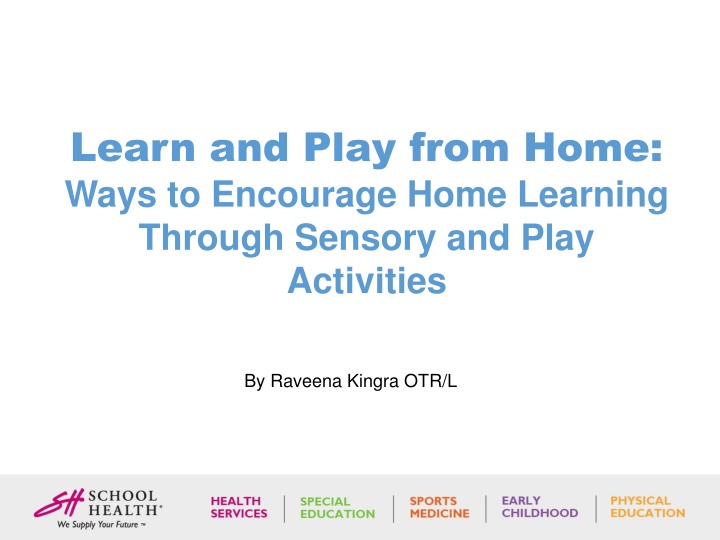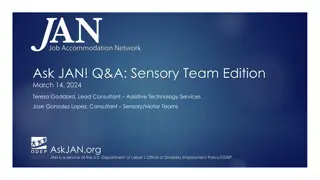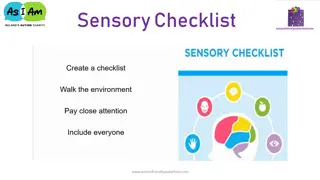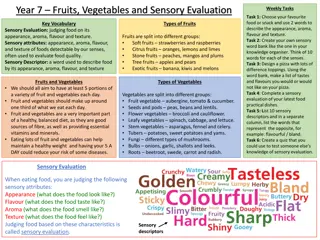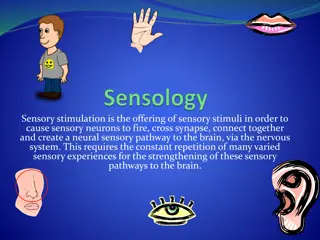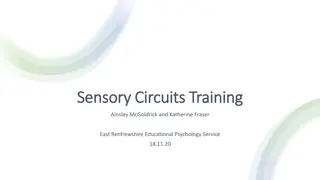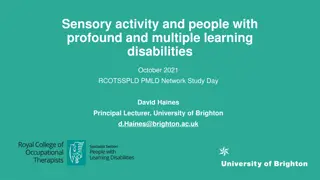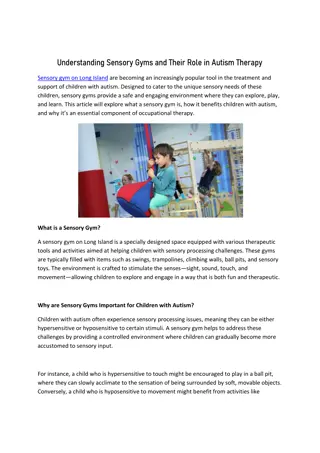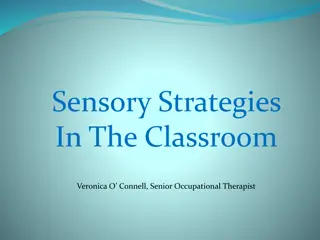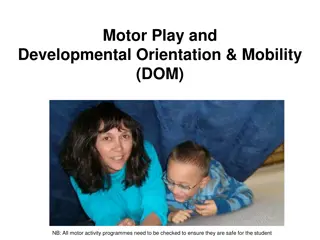Home Learning Through Sensory Play
Encourage home learning through sensory and play activities with routines, sensory strategies, importance of vestibular input, and more. Explore ways to create a customized schedule, incorporate timers, and understand alerting and calming qualities of vestibular input for children's development.
Download Presentation

Please find below an Image/Link to download the presentation.
The content on the website is provided AS IS for your information and personal use only. It may not be sold, licensed, or shared on other websites without obtaining consent from the author.If you encounter any issues during the download, it is possible that the publisher has removed the file from their server.
You are allowed to download the files provided on this website for personal or commercial use, subject to the condition that they are used lawfully. All files are the property of their respective owners.
The content on the website is provided AS IS for your information and personal use only. It may not be sold, licensed, or shared on other websites without obtaining consent from the author.
E N D
Presentation Transcript
Learn and Play from Home: Ways to Encourage Home Learning Through Sensory and Play Activities By Raveena Kingra OTR/L
Objectives How to create a routine for your student/child At-home sensory strategies to promote learning At-home education/play strategies to promote learning K-12
Routine Routines are important to normalize the day for students For non-verbal and young children/students create a picture routine Talk with parents to see what their schedules are like and create a customized schedule
Courtesy of https://busytoddler.com/2020/03/dailyschedule-covid-19
Example Written Schedule Courtesy https://oilcity.news/community/2020/03/15/child-development-center-offers-ideas-for- home-based-activities-during-covid-19-closure/
Importance of Vestibular Input Vestibular input is the sensation of any change in position, direction, or movement of the head 2-3X per day, in the morning, afternoon, and evening, can help arousal levels to perform activities 15 minutes of vestibular input can last up to 12 hours Have child participate in vestibular input before completing an activity that requires sitting down/focusing
Alerting Qualities of Vestibular Input Child is sluggish, show, tired Unexpected, rapid movement Bumpy, jerky movement Changing direction Bouncing Head inversion (upside down)
Calming Qualities of Vestibular Input Child is crying, running, hitting, tantruming Slow, rhythmic movement Linear movement (one direction) Slow movement provided by deep pressure Predictable movement
Importance of Proprioceptive Input Proprioception is body awareness For students seeing proprioceptive input (crashing, climbing, holding pencil with deep pressure, seeking deep pressure) behaviors will lessen and students will be able to engage in learning Provide INTENSIVE INPUT to muscles and joints Weight bearing activities crawling, push-ups Resistance activities pushing, pulling Heavy lifting carrying books Running, jumping Deep pressure tight hugs, compression vest, weighted backpack, weighted lap pad Oral input chewies
Behaviors Proprioceptive Avoiding Proprioceptive Seeking Appears lazy or lethargic Avoids active activities (running, jumping, climbing) Can be a picky eater Prefers to sit still Avoids touch from others Seem uncoordinated Needs to look to do familiar activities Difficulty using stairs Runs into objects, walls, or people Uses extreme force Stomps, walks loudly Poor body awareness Kicks, bites, and hits Poor personal space Prefers tight clothing Chews clothing, pencils, fingers
Sensory Strategies at Home Swinging Riding a bicycle or taking a walk Swaying in a hammock Rock in rocking chair or rocking horse Lie on couch with head down looking at ceiling Rhythmic bouncing or rolling on large therapy ball Pulling child on a blanket Swinging in a blanket Jumping on trampoline or in bounce house Log rolling roll back and forth to retrieve objects like clothes or shoes Sit and spin or spinning in office chair Scooter boards Bouncing on a large ball Pass ball over head and through legs Summersaults Dancing, marching, twirling Imitating head positions Slide and climb on playground equipment Shake and stretch body Create an obstacle course to crawl under, over, through chairs, cushions, pillows, etc. Jumping rope Look through these strategies to inform parents which ones are best for the specific student
School vs At-Home At-Home School Swinging in a linear movement for calming input Pushing a weighted cart Movement break Jumping on a trampoline Compression vest Rocking in rocking chair Swinging in blanket or hammock Helping with vacuuming, carrying laundry basket, carrying box of toys YouTube movement break Go for walk (Go Noodle) Jumping on trampoline or bed Compression vest
At Home Sensory Strategies Student seeks pressure and proprioceptive input before completing a task. He would benefit from the following recommendations that should be completed for 15 minutes before sitting and attending to a task. Squeezes on shoulder and arm (joint compression) Carrying bin of toys from one room to another Completing a puzzle or activity with belly on the floor (prone) Throwing/kicking a heavy ball Wheelbarrow Rolling a therapeutic ball on back/bouncing on a therapeutic ball/completing activity with stomach on therapeutic ball
Sensory Diets At Home Items parents can use to complete sensory diets at home based on recommendations or the OT compression or deep pressure vest weighted rubber textured balls
Sensory Diets at Home Oral motor chews Wobble chair
Tactile Activities Sands Water beads
Sensory Activities with Supplies at Home Rice and beans in a bin Shaving cream Making slime/play dough
Early Childhood, Kindergarten, First Grade Pre-writing strokes Coloring Cutting with scissors Stringing beads Learning the alphabet and sounds Dressing Toilet training Making a simple craft Following one-two step directions Writing/tracing name Hand strengthening activities Core strengthening Try not to overwhelm the parent; focus on one task a week
Early Childhood, Kindergarten, First Grade Pre-writing strokes Coloring Cutting with scissors Stringing beads Making slime/play dough
Core Strengthening Activities Relay race of different poses! - Bear walk - Crab Walk - Bouncing on a therapeutic ball
Hand Strengthening Activities Playing with playdough (try putting bead in and have kids pinch them out) Crumpling paper into a small ball Squeezing sponges when taking a bath Water spray bottles, squirt gun Playing with Legos Stirring cookie/cake batter Cutting with scissors, coloring pictures Playing on a playground (climbing) Relay racing (bear crawls, wheelbarrow walks) Playing Twister Playing Operation Squeezing a glue bottle (making crafts)
2nd, 3rd, 4th Grade Handwriting (writing words and sentences) Cutting complex shapes Coloring complex pictures Hand strengthening Core strengthening Categorizing (animals, foods) Understanding feelings and emotions Completing a puzzle Crafts
Make Handwriting Fun Use different mediums o Shaving cream o Chalk board o Dry erase board Paint with Q-tips Use First, Then board Speak enthusiastically when child has tried the activity
Make Handwriting Fun Slant board Slate chalkboard Homemade slant board
Scissors Many different types of scissors. Ask your OT which scissors are suitable for your child!
5th, 6th, 7th, 8th Grade Learning to type (www.typing.com) Teaching emotion regulation skills Increasing technology skills Increasing organizational skills Following multi-step directions Hand strengthening Core strengthening Playing board games (match based on cognition)
High School Focus on becoming independent/participating in household o Cleaning, cooking, doing laundry Writing a resume Using Google Maps Following multi-step directions/list Playing board games Playing sports
Chores Easy Tasks Making bed Folding and putting away clothes Wiping surfaces Taking out trash Vacuuming floors o Model safety Washing dishes Model to your child the steps to wash dishes o Practice safety with them by supervising Doing laundry o Model to your child the steps to do laundry o Practice safety with them by supervising Talk with the OT and Speech therapist to determine if it is safe for your child to do more complex tasks without OT supervision. Safety is our number one priority! Hard Tasks
Safety Always discuss safety with your child when performing chores What should they do if a glass breaks while washing dishes? How long should they wait after microwaving food? Ho do they safely plug something in? How do they safely cut a sandwich in half? Can they verbalize/understand the proper steps to complete ______? Can they verbalize/understand how to practice the activity safely?
Citation Busy Toddler https://busytoddler.com/2020/03/daily-schedule-covid-19/ Pillar Child Development https://www.pillerchilddevelopment.com/vestibularInput.php Lemon Line Adventures https://lemonlimeadventures.com/proprioceptive-input-sensory- processing-explained/
